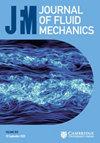Influence of outer large-scale motions on near-wall structures in compressible turbulent channel flows
IF 3.9
2区 工程技术
Q1 MECHANICS
引用次数: 0
Abstract
The influence of outer large-scale motions (LSMs) on near-wall structures in compressible turbulent channel flows is investigated. To separate the compressibility effects, velocity fluctuations are decomposed into solenoidal and dilatational components using the Helmholtz decomposition method. Solenoidal velocity fluctuations manifest as near-wall streaks and outer large-scale structures. The spanwise drifting of near-wall solenoidal streaks is found to be driven by the outer LSMs, while LSMs have a trivial influence on the spanwise density of solenoidal streaks, consistent with the outer LSM impacts found in incompressible flows (Zhou外层大尺度运动对可压缩湍流通道流近壁结构的影响
研究了可压缩湍流通道流中外大尺度运动(LSM)对近壁结构的影响。为了分离可压缩性效应,采用亥姆霍兹分解法将速度波动分解为螺线管和扩张成分。螺线管速度波动表现为近壁条纹和外部大尺度结构。研究发现,近壁螺线管条纹的跨度漂移是由外层 LSM 驱动的,而 LSM 对螺线管条纹的跨度密度影响微不足道,这与不可压缩流中发现的外层 LSM 影响一致(Zhou 等人,《流体力学》,第 940 卷,2022 年,第 A23 页)。扩张运动的特征是近壁小尺度行波包和外围区域的大尺度部分。近壁结构的流向平流速度保持在 $16 \sim 18u_{\tau }$,几乎不受马赫数、雷诺数和壁面温度的影响。用粒子图像测速法量化的近壁扩张结构的跨向漂移遵循一种不同于螺线形条纹的机制。这种漂移速度明显大于螺线形条纹的漂移速度,而且外层 LSM 的影响并不是这种漂移的主要触发因素。
本文章由计算机程序翻译,如有差异,请以英文原文为准。
求助全文
约1分钟内获得全文
求助全文
来源期刊
CiteScore
6.50
自引率
27.00%
发文量
945
审稿时长
5.1 months
期刊介绍:
Journal of Fluid Mechanics is the leading international journal in the field and is essential reading for all those concerned with developments in fluid mechanics. It publishes authoritative articles covering theoretical, computational and experimental investigations of all aspects of the mechanics of fluids. Each issue contains papers on both the fundamental aspects of fluid mechanics, and their applications to other fields such as aeronautics, astrophysics, biology, chemical and mechanical engineering, hydraulics, meteorology, oceanography, geology, acoustics and combustion.

 求助内容:
求助内容: 应助结果提醒方式:
应助结果提醒方式:


